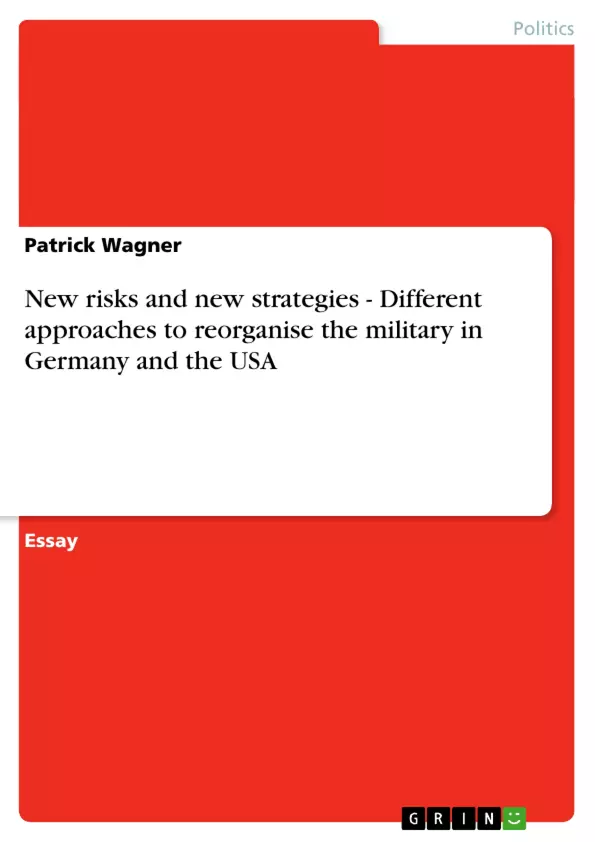For centuries, inter-state war has been standard practice in international relations. In the second half of the twentieth century the possibility of a nuclear confrontation between the United States and the Soviet Union was the major security concern in the world. Yet, with the end of the Cold War, the security threats states are faced with have changed radically. The risk of a major nuclear war has virtually disappeared. “Global nuclear warfare is no longer the primary international security concern.” Today, war as a means to settle international disputes has largely been eliminated. The developed countries have established a security regime that safeguards peaceful relations among them. “[…] war among the leading great powers – the most developed states of the United States, West Europe, and Japan – will not occur in the future, and indeed is no longer a source of concern for them.”
However, the world is by no means safer than it has been in the past. New risks like international terrorism, organised crime, the proliferation of nuclear, chemical and biological weapons to rogue states or criminal organisations, political or religious extremism, diseases like HIV/Aids, environmental disasters, poverty and inequality, etc. present new challenges to states and societies. Traditional security institutions like the military are not necessarily capable of dealing with these new risks, but must redefine their role and need to be reformed.
Different countries have different approaches to the reform of their military, perhaps most significant is the difference between the USA and Germany. While the US military reform is concentrated around technology and strategies, Germany goes beyond the purely operational level, recognises that the new security challenges cannot be dealt with by simply modernising weapons systems and instead seeks to reform the institutional framework of the military.
Inhaltsverzeichnis (Table of Contents)
- New Risks and New Strategies - Different Approaches to Reorganise the Military in Germany and the USA
- The Changed Security Environment
- The German Approach to Military Reform
- The US Approach to Military Reform
- Conclusion
Zielsetzung und Themenschwerpunkte (Objectives and Key Themes)
This essay aims to compare and contrast the approaches to military reform undertaken by Germany and the USA in response to the changing security landscape of the 21st century. The essay explores the reasons behind these divergent strategies, considering the perceptions of the military within each country and their respective roles in the international community.
- The changing nature of security threats
- The role of the military in a post-Cold War world
- The different approaches to military reform in Germany and the USA
- The importance of international cooperation in security matters
- The challenges of adapting traditional military structures to new threats
Zusammenfassung der Kapitel (Chapter Summaries)
The essay begins by outlining the changing security landscape and the new challenges posed by threats such as terrorism, organized crime, and the proliferation of weapons of mass destruction. It then examines the German approach to military reform, emphasizing its focus on institutional restructuring and a move towards a more inclusive security policy. The essay highlights the recommendations of the Weizsäcker Commission, which called for a smaller, more modern Bundeswehr with a primary focus on crisis prevention and management. It also discusses the German military's shift towards international cooperation and its participation in peacekeeping missions.
The essay subsequently explores the US approach to military reform, focusing on the emphasis on technology and strategies outlined in the Quadrennial Defense Review (QDR). It highlights the importance placed on the development of new weapons systems and the need to adapt traditional military thinking to deal with new threats such as terrorism. The essay examines Rumsfeld's vision of "transforming the military," emphasizing the importance of non-traditional strategies and a willingness to use unconventional tactics. Finally, the essay discusses the US approach to international cooperation, highlighting its emphasis on unilateral action and its reluctance to compromise its strategic objectives in the pursuit of international consensus.
Schlüsselwörter (Keywords)
The key themes and concepts explored in this essay include: military reform, security threats, international terrorism, organized crime, weapons of mass destruction, crisis prevention and management, international cooperation, peacekeeping missions, technology, non-traditional strategies, and the role of the military in the 21st century.
- Citar trabajo
- Patrick Wagner (Autor), 2003, New risks and new strategies - Different approaches to reorganise the military in Germany and the USA, Múnich, GRIN Verlag, https://www.grin.com/document/22372



